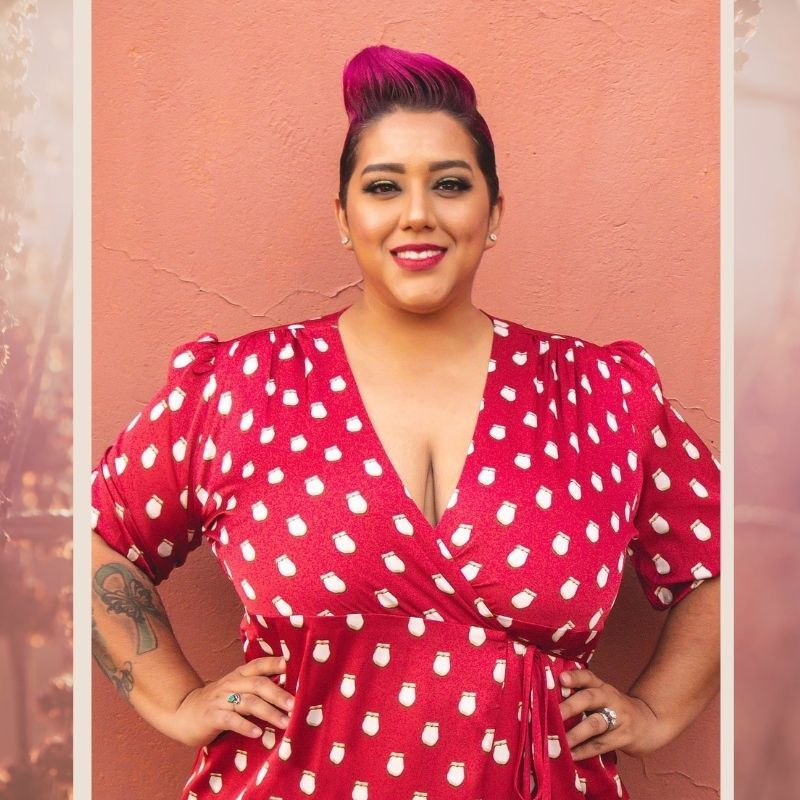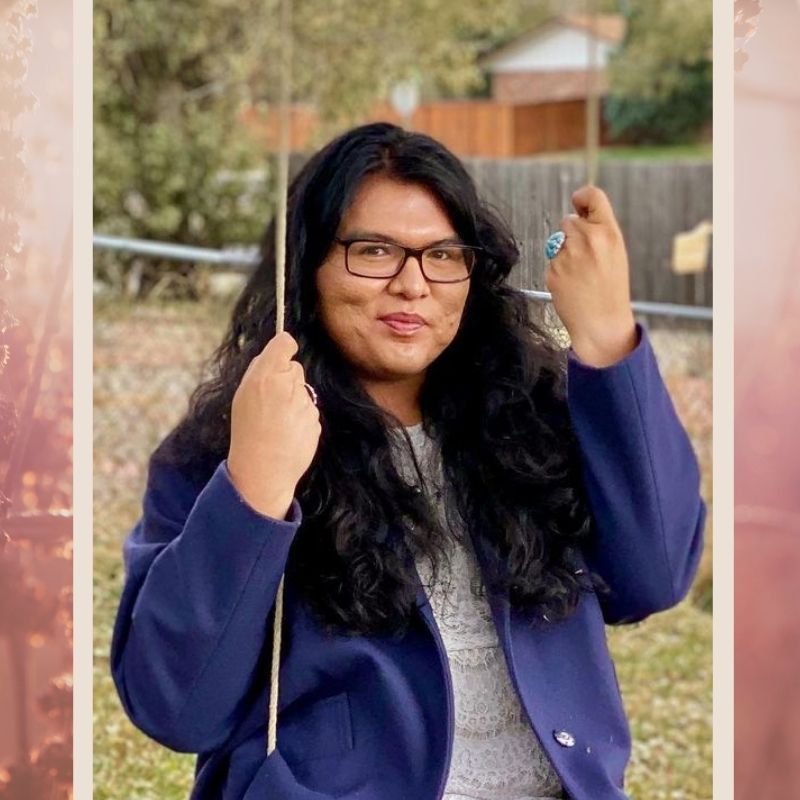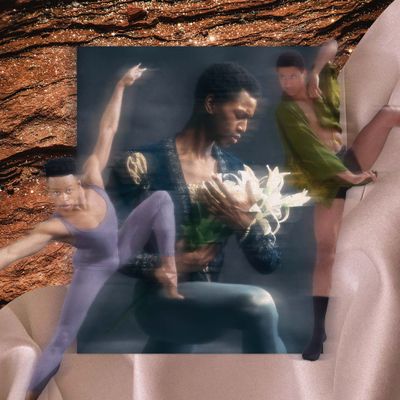In partnership with PRZM

PRZM is a global next gen community and modern marketing agency. From viral TikToks to game-changing insights – think of them as your Gen Z partner-in-crime – helping brands and organizations authentically engage next gen audiences at the intersection of fashion, luxury, art, tech, and culture.
Growing up in the early 2000s, I can tell you there wasn’t much Indigenous representation in popular culture.
Movies and television hadn’t made space for Indigenous stories, except for perhaps on the History channel and in stereotyped Disney films. I never saw many people who looked, dressed, or acted like myself or the generations of Indigenous relatives that preceded me. Because I didn’t see us in the media I was consuming, I didn’t think people like my family even existed anymore. This erasure often made me insecure about myself, my expression of beauty, and on the most fundamental level, my genetic makeup for years.
I was fortunate to grow up in a household that stressed the importance of celebrating our Indigenous roots, but I wish the broader culture emphasized these same values: the importance of being seen. Like many people who were born in the South, I have mixed roots, but I identify as Afro-Indigenous, a descendent of Africans, the Moorish Americans, Cherokee, and Sappony Tribes.
For obvious and non-obvious reasons, I don’t seek to express the colonizer parts of my DNA too loudly. Between you and me, I seek to honor the beauty within my ancestral bloodline, not reinforce the power of those whose fingerprints were unwelcomed then — and remain unwelcomed within me today.
Moving to Los Angeles at 7-years-old, I was given a crash-course on the power of celebrity and eurocentric beauty pressure. It wasn’t long before I began getting bullied on the playground for the texture of my hair, my gender fluidity, the shape of my eyes, my meditation practices in the tree groves, my nonreligious beliefs, my early vegan exploration — the list goes on and on.
After leaving that environment I realized that I had two choices: I could destroy myself, internalizing the hate of those who sought harm against me. Or, I could learn to love myself because when I was alone, I knew there was nothing wrong with me in my eyes. So, I started to experiment with makeup — more specifically the practice of face painting as a form of protection and expression. I bought a yoga mat again, began learning to speak Nuwaupu, which is one of our native languages (and while I have since forgotten everything I learned, I did try!).
Slowly but surely, I began seeing the beauty within myself, and more generally, the beauty of Indigenous peoples. Which leads me to now, the year 2020, where I can’t go onto any social media platform without seeing some sort of Indigenous representation, people celebrating their tribes in their bios, TikTok videos of folks adorned in full traditional garb and paint, and photos of artists and their altars in magazines. It’s so beautiful to see this dream realized — my inner child beams with joy as I share my generation’s collective healing with my elders, many of whom are in their tender years and just now beginning to reclaim their own identities.
So, before this year is through, I want to highlight some of the next-gen Indigenous leaders pioneering the Indigenous beauty space. Keep reading to see what Indigenous beauty means to Nico Robledo, Coyote Park, Charlie Amáyá Scott, Kendra Jessie, Cece Meadows, and me…Grey.
Nicolas Kuauhtli Robledo Romero aka Nico Robledo, 22-years-old, He/Him/His, Mexican/Argentine (@nicodexico)

When you hear the words “Indigenous beauty” what’s the first thing that comes to mind?
The first thing that comes to mind is our features, our textiles, our gratitude and way of life, our ceremonies, and our spirit guides. I think about embracing our ancestral roots and traditions.
In what ways do you embrace and celebrate your Indigenous beauty?
I celebrate my Indigenous beauty through my music, my art, ceremonies, drum circles, dancing, being intuitive and grateful for life, and sharing this with others around me. I support Indigenous businesses and celebrate the act of letting our Indigenous beauty shine through.
Kendra Jessie aka Cedar Woman, 26-years-old, She/Her/Hers, Ukrainian/Cree (@kendrajessie)
When you hear the words “Indigenous beauty” what’s the first thing that comes to mind?
Indigenous beauty to me is much deeper than the surface level. It starts from within; it’s the beauty in your mind and in your heart. Indigenous beauty is not just what you see; it’s how you feel. Beauty is in our creation stories, it’s in our ceremonies, it’s in our teachings, it’s in our relationships with the animals, the plants, and the land. The Indigenous view is that everything is interconnected, therefore, I believe that Indigenous beauty encompasses the beauty of everything that we see, feel, and experience. It encompasses our whole existence as human beings.
Are there any early memories of feeling insecure or unsupported while embracing or practicing your ancestral beauty practices and standards?
I felt very insecure and unconfident throughout my younger years. Growing up as a mixed Indigenous woman, I always felt less than because of the fact that I was not fully European. I would often hear responses of disbelief and shock when I would tell individuals that I was part Indigenous. One time I had a male tell me that I didn’t look like most Indigenous women he had seen, and that I was, “the most beautiful Indigenous woman he had ever seen.” Which was a misleading implication that Indigenous women are not beautiful.
Cece Meadows, 35-years-old, She/Her/Hers, Xicana/Yaqui/Comanche (@cecemeadows)

When you hear the words “Indigenous beauty” what’s the first thing that comes to mind?
Me. My daughters. My sister. My niece. My mother. Grandmother. I always remembered thinking that we looked different compared to other people I grew up around but still thinking how beautiful they were. Especially my grandmother and great grandmother. They embodied what beauty was and still is for me. Our language. Our food. Our togetherness. Our hopes and our gratitude for everything we had. I come from a very hardworking and thankful family. That to me is beautiful.
Did you ever lean more into western and Eurocentric beauty standards/practices? If so, please explain how, why, and if you still do to this day.
I recently cut all my hair off and dyed it a hot pink-purple color. I think that’s as western as I get. Haha. I’m like a walking billboard for our people. I’m a t-shirt and jeans kinda girl. But every t-shirt I own is designed by Steven Paul Judd and you know a Native is coming, lol.
My earrings make statements that are designed by my good friend Kassie from Mean Right Hook Designs. My foundation is by an Indigenous beauty brand and it is my color. No need to try and make my skin a few shades lighter. My hair is normally long black, wild, and free.
I embrace who I am and how the creator made me. I am beautiful in my very own way and I don’t have to try to look like anyone else but me.
Coyote, 21-years-old, He/They, 2Spirit, Yurok/Cherokee/White/Korean (@nativeboytoy)

When you hear the words “Indigenous beauty” what’s the first thing that comes to mind?
When I hear the words Indigenous beauty, I think about the matriarchs in my family. I think about the sweat on my papa’s back as he rode his NDN motorcycle from the Klamath River across Turtle Island. Something beautiful in their legacies and the lines in their faces that have been carved out from time through their aging.
Indigenous beauty is the Native friend’s noses that have bumps like mine. It is when I see another queer Native person that I look back at and double-take because I swore I saw my face in theirs. 2Spirits, Indigequeers, and Trans natives are Indigenous beauty to me.
Blessings, gifts, and kin that’s existences are sacred. My elders are Indigenous beauty to me, connected by blood, connected culturally, or those that have surrounded me and other Natives with their love. Indigenous beauty is a poem I read from another Native writer that I read over and over again. Where it just hits me in my gut. The beauty is in the way that my lips move, sounding it out to my best friends and to the loves in my life.
Indigenous beauty is body reclamation; it is feeling good in my skin. It is trust built with a lover. NDN beauty is the very joy found in the everyday. Especially as people that’s existence alone challenges the state’s opposition to our joy.
What ancestral beauty ritual, tradition, or trait do you keep alive?
I want to keep facial markings alive. It unifies so many Indigenous people. Kanaka kin (Native Hawaiians), kin Native to the Pacific Islands (Maori kin for another example), and so many Island cultures have facial marking practices. Turtle Island (where I am Indigenous) has facial tattooing practices.
Tattooing isn’t a white thing. Whiteness killed many of our knowledge holders and practitioners. Indigenous tattooing is a language that is carried on our body, it is like constant kisses from our ancestors onto our face. I mean that in a very literal and not romanticized way. And when the hand-poked ink met my skin, it felt like elders reuniting with me. It is a tradition that has been dehumanized over and over again. I want to breathe new life into it. I am constantly filled with gratitude for Indigenous people reviving their tattooing practices. There is nothing more beautiful to me than an elder covered in traditional tattoos that they chose that hold culture and time in that ink.
Charlie Amáyá Scott, 25-years-old, She/They, Navajo (@dineaesthetics)

When you hear the words “Indigenous beauty” what’s the first thing that comes to mind?
I honestly just envision someone who fully embraces and is in the process of reclaiming their culture, language, traditions, and beliefs. There’s a becoming to them that is unique and rooted in their indigeneity.
What do you hope the next Indigenous generations keep in mind about their heritage?
I think it is wonderful and so needed. Yet, this process of redefining, reclaiming, and celebrating ourselves at this moment is something each generation does as we navigate and learn to be and become in this colonized world.
Grey, 23-years-old, She/He/They, African/Cherokee/Moorish American/Sappony (@rugratsinparis)

When you hear the words “Indigenous beauty” what’s the first thing that comes to mind?
I think about nature. I think about my cheekbones and the land I used to visit as a child that’s no longer there for us to roam freely on. I think about my relationship with my ancestors and the earth, I find those all so beautiful. Indigenous beauty will always be my father holding sage in my room and teaching me not to be afraid of ghosts. That to me is Indigenous beauty.
What do you hope the next Indigenous generations keep in mind about their heritage?
I hope they remember to look back a lot but only to move forward and expand upon what we’ve all said and done. New wave indigeny sounds cool to me. I feel like we all got our lives interrupted by colonizers so there is so much more growing we’ve got to do and traditions are meant to be honored but also reimagined and born into something new that better serves the world.







